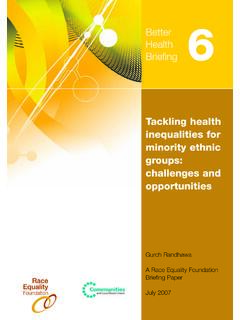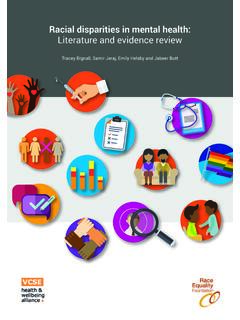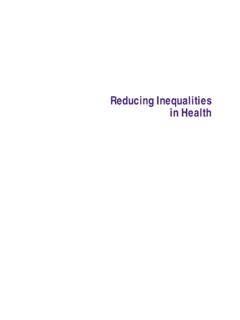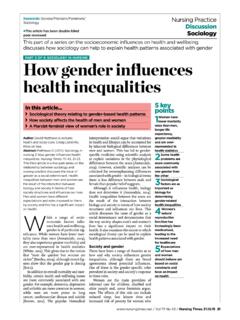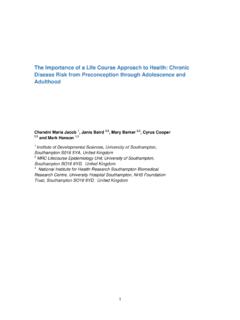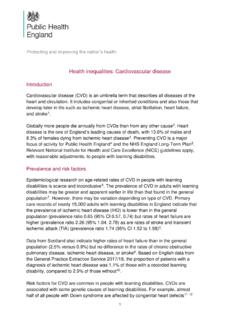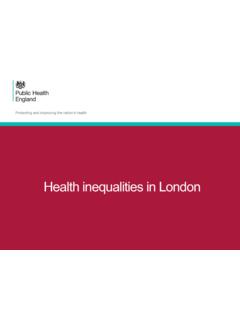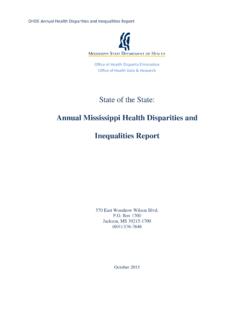Transcription of Ethnic inequalities in health: the impact of racism ...
1 Better health Briefing 3. Ethnic inequalities in health : the impact of racism Saffron Karlsen A Race Equality Foundation Briefing Paper March 2007. Better health Briefing 3. Ethnic inequalities in health : the impact of racism Key messages People from minority Ethnic groups experience poor treatment due to the 1. negative attitudes of others regarding their character or abilities. This occurs in their day-to-day interactions with other people as well as in their access to and interactions with services. Racist attitudes have been shown to affect health in a variety of ways. Understanding these processes is important for the development of effective policies to reduce the health disadvantage experienced by people from minority Ethnic groups in the UK. People respond to racist experiences in different ways. This makes evidence 2. of victimisation difficult to establish. In addition, the particular form it takes and victims' responses to it have an important influence on the health impact of victimisation Services have an important role to play: as a domain for racist experiences 3 and as a source of support for victims.
2 There is evidence that the responses of services to victimisation can influence its health effect, in both good and bad ways Encouraging trust among service users and minority Ethnic communities is 4 important for establishing a supportive and protective environment for those potentially at risk of victimisation. There is also a need for service improvement to address exclusion, even in the absence of evidence of racism . Introduction It is now well established that people from minority Ethnic groups experience poorer health than the Ethnic majority'. (Aspinall and Jacobson, 2004). Opinions on the causes of this tend to focus either on individual/community factors behavioural or biological influences, for example or on structural explanations: particularly the health impact of the socioeconomic deprivation experienced disproportionately by people from minority Ethnic groups (Nazroo, 1997, 1998, 2001).
3 The influence of racism on these patterns has often been underestimated. The experience of abuse, violence and other forms of negative treatment is part of the everyday lives of many people from minority Ethnic groups (Chahal and Julienne, 1999). Institutional racism ' is endemic in our public services (Macpherson, 1999; Coker, 2001; Blofeld, 2003). According to the Independent Inquiry into the death of David Rocky' Bennett: At present, people from the black and minority Ethnic communities are not getting the service they are entitled to. Putting it bluntly, this is a disgrace' (Blofeld, 2003, p. 58). This paper aims to present the evidence for the relationship between racism and health , and to highlight the need, and possibilities, for service improvement: both for the victims of racism and for people from minority Ethnic groups more generally. Racist victimisation makes people ill.
4 It can explain the health impact of (perceived) cultural' or biological'. differences (which are used as a justification for unfair treatment) and the concentration of people from minority Ethnic groups in socioeconomic and other forms of disadvantage. Such experiences can justify the distrust, described by people from minority Ethnic groups, in their relationships with individuals from other Ethnic groups, including service staff (Grewal and Lloyd, 2002). Effectively reducing health inequalities involves recognising and 1. Better health Briefing 3. Ethnic inequalities in health : the impact of racism responding to the impact of racist victimisation on health : if we do not act to Resources 1. address prejudice and negative stereotyping explicitly, whatever action we take to reduce inequality can only have partial success' (Equalities Review, 2007, p. 93). Clear guidelines for the development of culturally racism can manifest itself in a variety of ways 1 competent services: Harassment and discrimination involve behaviour or actions which unfairly penalise Kapasi, R.
5 And Silvera, M. and offend individual dignity. Discrimination may affect health in a number of ways. (2002) A Standards It may lead to: Framework for Delivering differences in opportunities ( in education or employment) and living Effective health and Social conditions; Care Advocacy for Black differences in treatment, leading to differences in access to health -promoting and Minority Ethnic resources; Londoners, London: King's stress both acute and chronic which produces physiological changes and Fund problems for mental well-being. (Frykman, 2006) resources/publications/. racism is an ideology which identifies a social group according to a particular biological characteristic and uses this to draw negative assumptions regarding that group's nature or capabilities (Karlsen and Nazroo, 2006). Racial harassment For good practice describes demeaning, threatening, violent or other forms of offensive, racially guidance on tackling motivated behaviour by individuals from one Ethnic group towards those of another.
6 Harassment and One in five respondents to the 2005 Home Office Citizenship Survey (HOCS) from discrimination, see minority Ethnic groups said that they were worried about being physically attacked because of their skin colour, Ethnic origin or religion (Kitchen et al., 2006). Others AndStatistics/Publications/. talk about how racism is endemic in British society (Fenton and Karlsen, 2002). PublicationsPolicyAndGuidance/. Victims of racial harassment describe their health as being poorer than that of non- PublicationsPolicyAndGuidance victims. Experience of racist verbal abuse or physical violence is related to a greater Article/fs/en?CONTENT_ID=. risk of premature death; high blood pressure; respiratory illness; lower self-esteem 4009459&chk=9 XTCv0. and life satisfaction; psychological distress, depression and anxiety; suicidal This website also offers tendencies; stress and anger; psychosis; and more work-limiting long-term illness guidance on building up a and disability (Krieger, 2000; Karlsen and Nazroo, 2002; Williams et al.)
7 , 2003). It has more diverse workforce also been linked to cigarette smoking and alcohol use, and to low birthweight within the NHS, which sets among the children of victims (Williams et al., 2003). the standards that will be expected of all NHS. Racial discrimination is sometimes divided into intentional (direct) and unintentional employers in tackling racial (indirect) discrimination. Unintentional discrimination occurs when someone (from a harassment, while allowing minority Ethnic group) is either unable to comply with a requirement that cannot be for local actions to be justified other than on racial' grounds (such as policies using length of residence as tailored to meet local the basis for allocating social housing), or is less likely to be able to do so than circumstances, policies people from other Ethnic groups. This definition recognises that someone who is and issues.
8 Non-prejudiced may be discriminatory as a result of the policies of the institution for which they work. Thus, although individuals might make substantial effort to eliminate discrimination, institutional rules, culture and habits prevent this from being fully realised (Macpherson, 1999). This is often evidence of institutional racism . 2. Better health Briefing 3. Ethnic inequalities in health : the impact of racism Institutional racism refers to the continued (conscious or unconscious) use of unfair policies or procedures by large-scale enterprises with no consideration as to how this may disadvantage certain Ethnic groups (Macpherson, 1999). It is associated with poor health and bodily function, cardiovascular disease , poorer mental health , and smoking, but its health impact is also indirect. Institutional racism is believed to explain the concentration of people from minority Ethnic groups in lower income households, environmentally and economically poorer areas, poorer quality and more overcrowded accommodation, less desirable occupations, and longer periods of unemployment than their Ethnic majority counterparts (Krieger, 2000; Nazroo, 2003).
9 However, whereas the health impact of socioeconomic disadvantage is well established (Acheson, 1998), the extent to which this disadvantage is a consequence of institutional racism is difficult to determine. Almost a third of minority Ethnic respondents to the HOCS believed they would be treated unfairly by council housing departments, housing associations and private landlords, and 12 per cent said that they had been refused a job or treated unfairly at work for reasons related to race' in the past five years (Kitchen et al., 2006). Evidence provided to the Equalities Review (2007) found that people from minority Ethnic groups experience more problems finding work appropriate to their abilities, skills or needs compared with white people. Almost a third of respondents to a survey of social services staff reported racism from colleagues and managers, with 45 per cent describing racism from clients (Brockmann et al.)
10 , 2001). Almost 60 per cent of the minority Ethnic NHS staff responding to Lemos and Crane's (2001) study had experienced or witnessed racial harassment in the previous year. Examples of oppression include a lack of support, impoliteness, derogatory and insensitive comments, unfair treatment and undermining of professional ability (Brockmann et al., 2001; Alleyne, 2004). Respondents talked about a grinding down process', which, over time, produced symptoms of stress. Some victims experienced late onset diabetes, hypertension, chronic fatigue syndrome and clinical depression (Alleyne, 2004, p. 6). The varied, and sometimes discrete, nature of both harassment and discrimination means that they can be difficult to identify. In addition, discrimination may sometimes mean that things do not happen when they should such non-events' (Williams et al., 2003) include not being called for an interview, not receiving the right treatment, or being refused assistance by social services.
